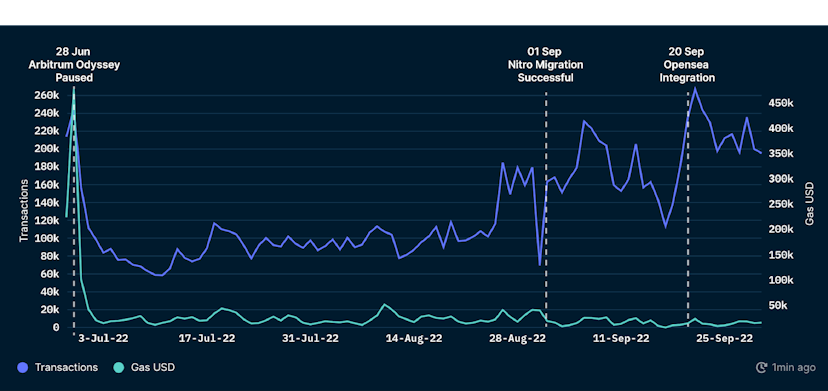Layer 2 Gas Usage Up 170% in 2022 as Adoption Surges
Arbitrum Continues to Lead Sector After Nitro Upgrade and OpenSea Integration
By: Samuel Haig • Loading...
DeFi
Ethereum’s Layer 2 (L2) ecosystem is seeing record network activity despite the bear market, with the monthly gas spent on settling L2 transactions set to post its second consecutive all-time high.
November’s L2 gas spend is already at 89B units, up from 76.6B for all of October, and up 170% since the year began, according to Dune Analytics.

Monthly gas spent to settle Ethereum L2 transactions. Source: Dune Analytics
Anthony Rose, head of engineering at Matter Labs — the company behind the ZkSync Layer 2 network, told The Defiant that the increase in Layer 2 gas expenditure demonstrates increasing adoption of L2s.
“L2s pay for their activity on Ethereum, and as we see activity increasing on these systems we do expect to see a corresponding increase in their expenditure on L1,” Rose said.
Layer 2 networks are the leading scaling solutions for Ethereum. Transactions executed on L2 chains are bundled together for finalization on the Ethereum mainnet, with Layer 2 chains offering a massive reduction in transaction costs while still inheriting the robust security of the Ethereum network.
“I believe that L2s (and eventually L3s etc) will be where most of the user activity is before too long because the price of using the systems will be dramatically lower than L1,” Rose said. “In the fullness of time, I think future users may be shocked that we were once trading monkey jpegs on L1. Ethereum’s roadmap is designed with this rollup-centric future in mind.”
Ethereum’s Layer 2 ecosystem currently has $4.3B in total value locked. Arbitrum is the leading chain with 53% of the sector’s combined TVL, followed by Optimism with 28%.
Arbitrum contributed heavily to the recent uptick in L2 activity, with the network enjoying a surge in transaction volume following the launch of its Nitro upgrade and expansion of its NFT ecosystem.
Arbitrum Odyssey
Arbitrum’s transaction volume rose in June with the launch of its Odyssey program, which rewarded users for activity on the network with NFTs. The event is rumored to culminate in an airdrop for participants, inspiring many airdrop opportunists to join in on the action.
However, the surge in activity caused problems for the network, with transaction fees briefly exceeding those on Ethereum’s mainnet, prompting OffChain Labs to pause the program. Daily transactions slumped as low as 80,000 in July after the Odyssey was put on hold.

Daily Arbitrum transaction volume. Source: Nansen
But Arbitrum migrated to a new tech stack called Nitro on Aug. 31, driving a 600% improvement in transaction throughput alongside a 75% reduction in transaction fees.
Nitro Upgrade
Transaction volume quadrupled after the upgrade, hitting new all-time highs after the leading NFT marketplace, OpenSea, launched support for Arbitrum-based NFTs in September.
Importantly, gas fees have remained steady despite the spike in network activity. According to Nansen, average gas fees fell to $0.08 from $0.35 after the Nitro migration.
While existing Layer 2 networks have already made huge strides in reducing the fees and improving throughput for users transacting on Ethereum, many developers are tipping that zero-knowledge rollups will be the next frontier for Ethereum scaling.
Leading L2s Arbitrum and Optimism currently use optimistic rollups, which compromise on scalability in exchange for compatibility with the Ethereum Virtual Machine (EVM), Ethereum’s smart contract engine. Withdrawals from optimistic rollups to the Ethereum mainnet also take seven days to finalize for security purposes.
Zero-Knowledge Rollups
By contrast, rollups that are powered by zero-knowledge proofs offer improved scalability and transactional privacy, and fast withdrawals to the mainnet. While existing ZK-powered scaling solutions do not offer EVM compatibility, the development teams at Matter Labs, Scroll, and Polygon, all believe they are on the precipice of shipping EVM-compatible ZK-rollups.
Mihailo Bjelić, the co-founder of Polygon, said that developers can deploy any existing Ethereum contracts to zkEVM rollups without making any modifications to the code. He further revealed that Polygon’s zkEVM is expected to launch its mainnet in early 2023, and that its testnet currently hosts more than 1,500 smart contracts and decentralized applications.
Layer 3s
While Matter Labs plans to ship its own zkEVM-powered rollup, zkSync 2.0, in the coming months, Rose said that his team is already planning for application-specific Layer 3 blockchains to take the reins in scaling Ethereum.
“L2 is really just the first step toward massive scalability,” he said. “Before too long, we’ll see the launch of L3s and several other scaling improvements that various teams are working on. We have our L3 proof of concept in design right now.”
Advertisement
Get the best of The Defiant directly in your inbox 💌
Know what matters in Web3 with The Defiant Daily newsletter, every weekday
90k+ investors informed every day. Unsubscribe anytime.